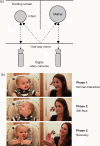Mothers who are securely attached in pregnancy show more attuned infant mirroring 7 months postpartum
- PMID: 25020112
- PMCID: PMC4301602
- DOI: 10.1016/j.infbeh.2014.06.002
Mothers who are securely attached in pregnancy show more attuned infant mirroring 7 months postpartum
Abstract
This study contrasted two forms of mother-infant mirroring: the mother's imitation of the infant's facial, gestural, or vocal behavior (i.e., "direct mirroring") and the mother's ostensive verbalization of the infant's internal state, marked as distinct from the infant's own experience (i.e., "intention mirroring"). Fifty mothers completed the Adult Attachment Interview (Dynamic Maturational Model) during the third trimester of pregnancy. Mothers returned with their infants 7 months postpartum and completed a modified still-face procedure. While direct mirroring did not distinguish between secure and insecure/dismissing mothers, secure mothers were observed to engage in intention mirroring more than twice as frequently as did insecure/dismissing mothers. Infants of the two mother groups also demonstrated differences, with infants of secure mothers directing their attention toward their mothers at a higher frequency than did infants of insecure/dismissing mothers. The findings underscore marked and ostensive verbalization as a distinguishing feature of secure mothers' well-attuned, affect-mirroring communication with their infants.
Keywords: Attachment; Infant attention; Maternal mirroring; Mother–infant communication.
Copyright © 2014 The Authors. Published by Elsevier Inc. All rights reserved.
Figures



References
-
- Abidin R. Parenting Stress Index, 3rd edition, Professional manual. Psychological Assessments Resources; Lutz, FL: 1995.
-
- Ainsworth MDS, Blehar MC, Waters E, Wall S. Patterns of attachment: a psychological study of the Strange Situation. Erlbaum; Hillsdale, NJ: 1978.
-
- Ainsworth MDS, Wittig BA. Attachment and exploratory behavior of one-year-olds in a strange situation. In: Foss BM, editor. Determinants of infant behaviour. Vol. 4. Methuen; London: 1969. pp. 111–136.
-
- Arnott B, Meins E. Links among antenatal attachment representations, postnatal mind-mindedness, and infant attachment security: a preliminary study of mothers and fathers. Bulletin of the Menninger Clinic. 2007;71:132–149. - PubMed
-
- Bard KA, Myowa-Yamakoshi M, Tomonaga M, Tanaka M, Costall A, Matsuzawa T. Group differences in the mutual gaze of chimpanzees (Pan troglodytes). Developmental Psychology. 2005;41:616–624. - PubMed
Publication types
MeSH terms
Grants and funding
LinkOut - more resources
Full Text Sources
Other Literature Sources
Medical

